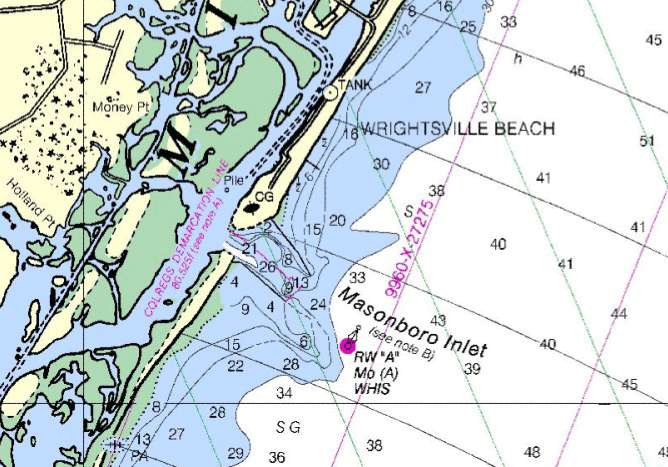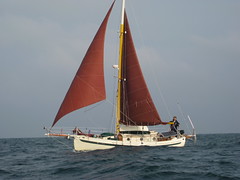This post can be found on Ben’s blog at BCCElizabeth.com. I entered the inlet just a few minutes after Ben and experienced it much in the same way. The only exception being that at one point I found myself outside the channel! Seeing an unlit green buoy to my right when staying in “safe water” would mean keeping all greens to the left was a little unnerving. But they are hard to find in the dark. I wanted to write about this experience, but Benji beat me to it and did it so well. Here are his words:
Uncharted Buoys & Moonless Inlet Entries
It’s been weeks of trudging our way south through the dismal ICW. The engine hours topped the 1000 mark and the associated fuel costs toppled the budget. The thought of open ocean and even just a short offshore run made Elizabeth and I very excited.
Beaufort, North Carolina offered us a chance to spread our tanbark wings and sail a single, unobstructed course from Morse Alpha to Morse Alpha. The run: Beaufort, NC to Wrightsville Beach, NC. Typically, it’s the first outside run for many of the sailboats making this southbound trip each year. It’s roughly a 70 mile trip, anchor to anchor.
The plan: Haul back at 0500 from Beaufort, drop the hook at 1900 in Wrightsville Beach. 14 hours at 5 knots…pretty ambitious. Sailing plans are the exact opposite of Swiss watches… they are never precise, and always fail. November days are short and darkness dominates this time of year. Translation: a dark departure and a dark arrival.
Leaving Beaufort in the early morning light and fog produced a beautiful view of Cape Lookout to port. Beaufort is a well marked channel, but strong current against us made it slightly tricky that morning. We were pushed Eastward towards Shackleford Point and only a massive course correction would compensate. Just as we cleared G “7?, the sun broke through and the winds filled in – a sweet 12 knot breeze from the Northeast, putting it on our starboard quarter. We both enjoyed the gentle lift of the ocean swells. With the Monitor engaged and steering well, I was able to get a few whipping projects done and enjoy the day.
The day wore on and the winds increased. By dusk it was blowing a steady 17-20 knots, and the seas had built to 4 or 5 feet. No longer did the Monitor steer my course easily. The bronze gears have been wearing down slowly over time and I think they have come to the end of their serviceable life. They are about the only parts on the Monitor I didn’t replace during my rebuild this past summer. Typical.
Around 1930, we approached the entrance to Wrighstville Beach – Masonboro Inlet. The seas were rather ‘pushy’ and the wind was cold. Despite having doused the mains’l a few miles back and running my engine in reverse to try and slow down, I ended up leading our 3 boat convoy: Daphne and Sabbatical were a few miles behind me, so I had won the prize of going in first. Damn this fast boat of mine!
The Mo (A) light was dim, but clearly recognizable by it’s distinct pattern (- —). Sailing under jib alone at 6 knots, with tiller between my legs, spotlight in one hand, binoculars in the other, VHF radio under my toes, and chart between my teeth I sped on towards this inlet beneath a pitch black sky. The chart reads: Masonboro Inlet (see note B). With one eyeball watching for the submerged breakwater, the other eyeball wandered around the chart looking frantically for this note B thing. Aha!
“Well shit, I hope these buoys are on station” I thought, because that’s all I got to go with here. “Hope I don’t miss any buoys, or skip a dog leg (an unexpected turn in the channel)!” There were lit red buoys exhibiting distinct light patterns, but without a chart to reference their position it was difficult to know which buoy to head for first. At this point I threw up my hands, chose the brightest red flash I could see and just went for it. Not much you can do, except pray. The submerged breakwater didn’t diffuse the waves of course, so even inside the inlet I was rolling nearly gunwale to gunwale. Too rough to use binoculars. Unlit green buoys whispered “boo” like a ghost close on my port side… too close actually. I clutched my radio, hailed Daphne, “Watch Out For Unlit Greens!” and swung the tiller over.
Once past the first red buoy, the channel became more recognizable and the path to safety was in sight. But that last red buoy, so far to port, so close to the southern breakwater… is that really on station? Can I trust it? Will it put me aground when my keel drops down between these swells? Spotlight on the breakwater, course as close to the red as possible…Oof, is this really worth it I wondered??? …YES! And what a rush it was, in fact.
Inside the last red and making way towards the ‘green on a stick’, with the swell gone flat, I lowered my jib safely and waited for the rest of my convoy to play the game. It was sorta like a roller coaster ride where you scream the entire ride in horror, only to get off and say, “That was fun, let’s do it again!”




Comments 6
seems you are becoming a real bluewater sailor, congratulations. lovely boat and it looks quite cozy. nice to see people living aboard, a personal aspiration.
Been there done that…..and got just as worried too. LOL
Still fun reading about your ride in. Glad all is well.
Hope that you had a wonderful Thanksgiving day feast , we did , onboard our boats , too !
Wow! I was nervous reading that! Somehow entering a strange port at night is always nervous and exhilarating. I think the calm of a harbor’s water lets our stress out. Beautiful boat and I’m looking forward to following your blog. Thanks for the charts and pics – It’s a great combination and if you don’t mind, I’ll purloin that for my blog.
Cheers!
– Jerr
Just what a mom wants to read…………….and as I read this..I hope your diver is having success!
I know how it is to have the slowest boat. Amalie was like that. If you ever do something like that again, think about that:
Take it easy, get up late, take your time clearing up your boat. Go in the afternoon. Out in the Ocean darkness does not endager you, or your boat. Sail into the harbour at dusk or be a little late…
Christine